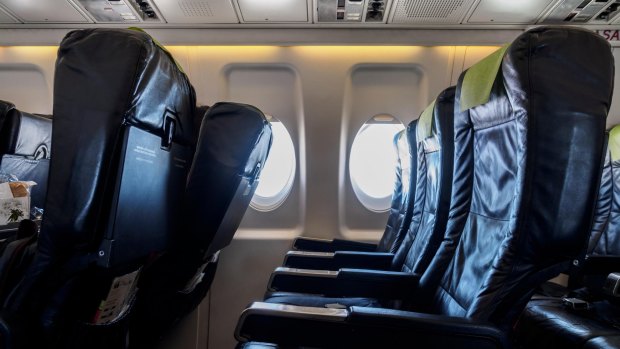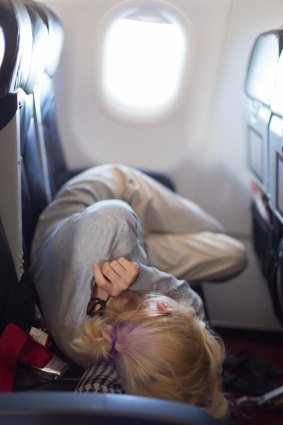This was published 6 years ago
Plane travel tips & advice: Which airlines fly with the most empty seats
By Oliver Smith

Empty seats mean lost revenue for the airlines.Credit: Alamy
Flying would be great if it wasn't for all the other passengers. There would be more space to stretch your legs, plenty of room for bags in the overhead bins, more attentive cabin crew, and fewer people coughing, snoring, and hanging around in the aisle with their backside in your face.
So the sight of empty seats is a welcome one for fliers. It offers the promise of peace and quiet, the chance to catch 40 winks, and, if you're very lucky, an upgrade to first class.
But for airlines - and the environment - nothing could be worse.

The sight of empty seats is a welcome one for passengers. Credit: Alamy
Empty seats mean lost revenue. If passenger load factor (PLF) falls below a certain level, the airline forfeits cash. If the problem persists, it could eventually go out of business. Conversely, raising the PLF is like getting free money. The plane has to fly regardless of how many tickets are sold. The fuel, landing fees and crew salaries have already been paid for, so extra seat sales guarantees a boost to profits.
Furthermore, carriers can reduce their environmental impact a little by maximising their PLF – it means lower emissions per passenger.
So which airlines are top of the class when it comes to empty seats – and which must try harder?
All hail Ryanair
For all its perceived flaws, the Irish no-frills behemoth is an efficient beast. Its PLF is the envy of the world. During the first seven months of 2017 it was 94.7 per cent. That rose to a remarkable 96 per cent for the period between April and December. Ryanair's planes each have 189 seats, so on any given Ryanair flight just seven or eight tickets go unsold.
That impressive PLF is one of the reasons why it will make an estimated £1.4bn ($A2.47bn) this financial year, while American Airlines, the world's biggest airline with around 80 million more annual passengers than Ryanair, but a PLF of just 82.6 per cent, only made £1.38bn in 2017.
Ryanair's low-cost rivals aren't far behind. EasyJet's PLF was 92.1 per cent last year, while Jet2's was 93.2 per cent. This is not surprising given that airlines selling cheaper tickets need a higher PLF to make enough money to survive.
The growing worldwide average
Ryanair's lofty figures compare to a worldwide average PLF of 81.4 per cent for 2017, as reported by the International Air Transport Association (IATA). That's a vast improvement on previous years. In 2016, according to IATA, it was 79.6 per cent, in 2011 it was 78.1 per cent, and in 2005 it was 75.1 per cent. Before 2000, around 70 per cent was the norm.
The dramatic rise has provided airlines, who regularly bemoan their tight profit margins, with a bit of financial wiggle room.
It is symptomatic of the rise of low-cost air travel, and suggest carriers are now smarter when it comes to sales forecasting and flight scheduling. And it means that while air travel, a major source of CO2 emissions, is still growing fast, at least it is becoming more efficient.
Is this why planes feel more cramped?
Ask anyone over a certain age and they will tell you that air travel used to be a far more luxurious experience, with bigger seats, and more space.
It's true that legroom has been cut. A 2014 study found that seat pitch (the distance between two seats) on America's four biggest airlines has fallen from between 31" and 36" to between 30" and 33", while seat width has dropped from between 19" and 20" to 17"-18.5".
It means carriers can cram more passengers onto their planes. Rows of 10 are commonplace on the Boeing 777, while last year Airbus started hawking an 11-abreast version of its A380.
But the very fact that planes are flying 11.4 per cent more full, on average, means aircraft simply feel more cramped too.
British Airways has been criticised in recent for trying to compete with the low-cost airlines, offering "basic" fares that don't include checked luggage and ditching free meals on short-haul flights. So is it catching up the no-frills carriers when it comes to PLF? Not yet.
From April to December last year its planes flew 81.2 per cent full, on average. So while 33.9m people travelled with BA during that period, there were almost eight million empty seats. That's virtually unchanged from the 81 per cent reported in 2014 but well up from the 73.3 per cent reported in 2010.
Flybe is bottom of the class
Budget airline Flybe has one of the worst PLFs – just 76 per cent for the period between April and September (the most recent statistics publicly available). The staple of Flybe's fleet is the Bombardier Dash 8, which has room for 78 passengers. On a typical Flybe service, however, 19 of these seats will be empty.
Other low PLFs include Austrian (76.8 per cent), Emirates (77.2 per cent) and Virgin Atlantic (78.8 per cent).
What does a failing airline look like?
Does a below average PLF mean an airline is failing? Not necessarily. The 77.2 per cent reported by Emirates is well below the global average of 81.4 per cent, but the airline is still extremely profitable. During the six months to September 30 last year it made £352m ($A622m). However, it is facing challenges. Terrorist attacks and political tension in the Middle East, and Donald Trump's policies, have all hit demand, and last year it was forced to cut the frequency of its flights to and from North America.
But a sharp rise increase in empty seats may also indicate bigger problems. Monarch's PLF in 2015 was 82.3 per cent; in 2016 that sunk to 76 per cent; in 2017 it ceased trading.
The Telegraph, London
Sign up for the Traveller newsletter
The latest travel news, tips and inspiration delivered to your inbox. Sign up now.